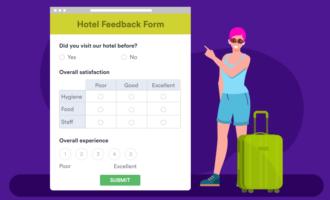Key Takeaways
- Customer service builds loyalty and drives revenue by assisting customers throughout their journey.
- Customer service differs from customer experience, as service focuses on direct support while experience covers all brand interactions.
- Offering multiple support channels ensures accessibility and customer satisfaction.
- Businesses must optimize training, gather customer feedback, and use the right tools to improve service.
- AI and automation enhance customer service, enabling faster responses, self-service, and personalized experiences.
- Jotform simplifies customer service management with feedback forms, automated reports, and CRM integrations.
One crucial business element has risen in importance among buyers in recent years and is a key driver for customer loyalty. This element is customer service, the act of supporting or assisting customers throughout their relationship with your brand. As your brand’s first impression, exceptional customer service creates long-term relationships and increases revenue, while poor service can lead to customer churn.
Personalization is essential to effective customer service, and providing great customer service will make your business stand out from competitors. There are several core customer service channels you can personalize, including phone, live chat, email, online support portals, social media, self-service, in-person, and omnichannel support.
Improving customer service requires understanding common challenges, getting the right tools, building an effective training program, creating a customer-centric culture, and listening to customer feedback. Read on to find out how to utilize personalized customer service to build loyalty.
Definition of customer service
With the first formal customer service teams dating back to the 1760s, this approach has always been central to modern business. But what is customer service?
Customer service comes in many different forms, but this term refers to supporting or assisting customers before, during, and after they interact with your business. Customer service requires your team to practice empathy, going above and beyond to hear and fix customer concerns.
One of the core elements of any successful business, customer service can be your key to success — or the downfall of your brand, depending on your execution.
Building an effective customer service strategy requires a keen understanding of the value, trends, and tactics behind this age-old idea. In this comprehensive guide, we break down the ins and outs of customer service — from the fundamentals to the future — so you can better understand, anticipate, and address your customers’ needs.
The rise of customer service
Customer service has always been an essential part of any business, but its value for consumers has grown in recent years. Since 2019, the focus on improving the customer experience has increased by 19 percent, likely attributed to a shift in consumer expectations and the rise of modern technology.
Today’s customers want fast, available solutions to their issues and expect a personalized experience from the brands they interact with. With the level of accessibility that technology now provides, businesses experience pressure to evolve their customer service practices to match the efficiency and responsiveness their customers expect.
The use of customer service to create loyal customers
Every brand provides some form of customer service, but a select few offer a service experience that truly sets them apart. For those who can meet shifting customer expectations by going above and beyond, the quality of your customer service can become a differentiating factor in building brand loyalty.
Customers who are treated well and feel that a brand meets their needs are more likely to return in the future. In fact, 72 percent of shoppers are willing to spend more for a brand that offers top-tier service, while 32 percent say they would fall in love with a brand due to great service.
To nurture your brand loyalty and build your customer value, you must be willing to invest time and money into optimizing your customer service experience. You can start by identifying which tactics you should include in your strategy.
Examples of customer service
Every business has a different approach to customer service and must adapt to meet their customer base’s unique needs. However, consider using some of these common customer service tactics:
- Answering frequently asked questions
- Actively listening to and collecting customer feedback
- Resolving customer issues
- Facilitating returns and exchanges
- Offering personalized shopping recommendations
Customer service vs customer experience
So, what is the difference between customer service and customer experience? Unlike customer service objectives, which focus more on the problem-solving aspect of your business’ interaction with consumers, customer experience is more all-encompassing (and more customer-driven, oddly enough).
Customer experience refers to your customers’ perception of and participation with your brand, while customer service objectives focus on the assistance your brand provides customers when approached with issues or questions.
Every interaction your customers have with your brand is considered a part of your customer experience and colors the public perception of your company. While customer service may be part of your customer experience, it’s not the only element at play.
For example, a customer viewing or interacting with one of your social media posts is part of your customer experience, while a customer messaging an agent about an issue with their online purchase is customer service. Both are part of your online customer experience, but your social media post does not qualify as customer service. In short, customer service is just one important factor of the overall customer experience.
However, the quality of your customer service can impact your overall customer experience, so it’s important to build a strategy that emphasizes both elements. While you should continue to provide top-notch customer service, you should also foster your customers’ loyalty outside of service-based interactions.
Customer support vs customer service
Customer support is also similar to customer service, but what separates customer support from customer service is a difference in scope and focus. While customer service offers broad assistance across many facets of the customer experience, customer support provides more technical assistance.
For example, customer support may help software users troubleshoot a feature’s functionality. Meanwhile, customer service would assist users in finding the right software solution for their business. Both provide valuable information and assist customers, but they operate on different levels and during different stages of the customer journey.
For most businesses, understanding customer service by itself may seem straightforward. But when companies don’t prioritize customer service, these businesses are forced to face the consequences. Modern consumers place customer service top of mind when choosing a brand to invest in, so knowing why this business element is important can help you avoid costly missteps.
The necessity of customer service
Now that you understand the ins and outs of customer service, the question remains: Why is customer service important? Customer service not only acts as an extension of your brand, but it’s also the impression that sticks with your customers the longest. This makes the service you provide essential toward securing and maintaining customers. In fact, 88 percent of customers say that the experience a company provides is as important as its products or services.
Quality customer service helps build trust between customers and your company — making them feel supported and appreciated. Customers who feel supported are more likely to recommend your brand to others — 59 percent of consumers say they would recommend a brand to others based on the customer service they receive.
Customers are also more likely to build long-term relationships with your brand and increase their customer lifetime value (CLV) — maximizing your revenue without stretching your marketing budget. Knowing how to calculate customer lifetime value can help you measure your performance and tweak your strategy to optimize this metric.
Pro Tip
Enhance the customer service experience with Jotform AI Agents by delivering personalized, conversational AI interactions, providing 24/7 support, automating inquiries, and ensuring secure, transparent, and efficient customer assistance.
Customer loyalty and retention through customer service can also mean major improvements to your bottom line. According to a study by Bain & Company, increasing customer retention rates by 5 percent can increase profits by 25 to 95 percent.
Personalization is key to this connection, as 73 percent of consumers expect businesses to understand them as individuals and provide unique service. Meanwhile, 66 percent of customers prefer a brand that can make personalized product recommendations, and 73 percent want to be treated like a person, not a number.
On the other hand, providing lackluster customer service can be detrimental to your brand’s reputation — and, by extension, your revenue. When it comes to subpar customer service, 33 percent of people would consider switching companies after a single bad experience.
Poor customer service not only drives your customers into the arms of competitors, but also turns these consumers into detractors. Only 15 percent of consumers who classified their customer experience as very poor considered recommending that brand to others. In some cases, these customers may even discourage others from interacting with your brand through social media, negative reviews, or word of mouth.
To set yourself apart from the competition with quality customer service, it’s important to know which support channels are most commonly used and for what purpose — and which solutions are most effective for your business. Different service channels have unique advantages and disadvantages, so understanding the purpose of each is essential.
Key types of customer service
Customer service takes many forms and continues to evolve as time goes on. Gone are the days when call centers were the only option for remote customer service — although phone support still plays an important role in today’s customer service infrastructure.
Understanding what types of customer service to offer
Knowing the right types of customer service to offer your customers requires an understanding how customer needs and expectations correlate with the benefits of certain service channels.
Consider the most common approaches to customer service to make the right decision for your business:
- Phone: Still one of the top forms of customer service, traditional phone-based support is essential for older customers and for handling complex issues requiring real-time agent interaction.
- Live chat: Rapidly becoming a favorite of today’s consumers, live chat offers the real-time benefits of voice without the need to hop on the phone. Messaging is convenient, fast, personal, and secure — allowing customers to solve their problems instantly.
- Email: A less time-dependent solution, email allows customers to handle issues at their own pace. Customers can interact with agents and get detailed responses without the need to stay glued to their phones for an extended period.
- Online support portals: Support portals act as a one-stop shop for your customer’s support needs. Customers can submit, track, and resolve tickets from a single accessible location.
- Social media: With most consumers accessing information and interacting with brands on social media, offering customer service on these channels is a must. Customers can message your brand directly on their favorite social media platforms, increasing your brand’s accessibility and benefits.
- Self-service: This channel is essential for establishing excellent customer service. Some consumers would rather resolve an issue independently — and offering an effective self-service solution can boost customer satisfaction and reduce support costs.
- In-person or onsite support: Onsite support is your brand’s last line of defense against potentially detrimental customer issues. Having in-person support at your store or point of sale allows your team to proactively handle concerns and support customers before, during, and after their purchase.
- Omnichannel: The value of omnichannel service comes in maintaining a record of customer information. Omnichannel customer service connects conversations from channel to channel without losing conversation history or context — creating a seamless service experience for customers no matter how they contact you.
For today’s customer, you will likely need to utilize multiple customer service options. Using a combination of these tools provides comprehensive coverage for your brand and helps increase the satisfaction of your service experience.
Pro Tip
Optimize various customer service types with an AI phone answering system for quicker and smoother assistance.
Understanding customer service satisfaction levels
No matter what channels you use, tracking how your customers perceive your service is important. There are several ways to measure your customer service satisfaction levels, such as a Net Promoter Score® (NPS®), but you can also use a basic scale to evaluate your current success.
Consider this scale as a starting point, ranking levels of customer service from least to most positive:
- Unsatisfactory: Lacks any of the elements customers expect from customer service and may be a reason customers steer others away from your brand or choose not to return.
- Basic: Provides the bare minimum in all facets of customer service.
- Average: Meets customer expectations but does not exceed them.
- Desired: Shows a commitment to customer service, but nothing truly exceptional.
- Unbelievable: Demonstrates customer service as a top priority. Consumers rave about your brand and may even recommend your brand to others based on customer service alone.
Using this scale, you can set goals and compare them to your business’s performance. If your team isn’t meeting the mark, it’s time to consider new ways to improve your customer service in the future.
Ways to improve customer service
Whether you already have a customer service strategy or are starting from scratch, knowing how to adapt to modern expectations and optimize your approach is crucial. Consider how these challenges may impact your customer service and try using our suggested tactics to elevate the quality of your service.
Common customer service challenges
The evolution of customer service technology may provide opportunities to create a better experience for both your customers and team members, but with it also comes a new wave of potential issues. As you work to improve or build your strategy, keep these common customer service challenges in mind:
- Complexity of issues: Glitches, user errors, or unexpected crashes can lead to unforeseen headaches if not resolved quickly. That’s why you must train your team well and ensure they can efficiently tackle complex issues.
- Expectations of fast resolutions: In the age of instant gratification, modern customers expect your brand to fix issues quickly. And what was once considered fast may not cut it anymore, so tracking resolution times is essential to monitoring success.
- Consistency across channels: With so many options available for customers to interact with your brand, your customer service team must ensure the messaging and quality remain the same — no matter where they’re contacted.
Some of these challenges may be unavoidable, but with the right tactics, you can set your team up to respond proactively and avoid unwanted complications.
Tactics for improving customer service
Knowing how to improve your customer service will depend on the current gaps in your strategy. While you may consider your current approach to be effective, there’s always room for improvement. To elevate your customer service performance, try using the following customer service tips as a roadmap:
Optimize your training
Quality service starts by building a strong foundation with your team. Providing your employees with effective customer service training will help them better navigate problems, resolve issues quickly, and approach customer interactions with empathy.
A key element of customer service training is ensuring consistency across each agent interaction — no matter the channel. Take the time to establish clear messaging and expectations for customer interactions while training employees to incorporate buyer data to create a sense of personalization.
It’s also important that you provide comprehensive training on products, services, and communication techniques to equip agents with the skills and product authority to address customer inquiries and concerns. Building independence among agents reduces inefficiencies and raises their confidence during customer interactions.
Foster a customer-centric culture
Securing your team’s buy-in is another essential element of successful customer service. While customer service skills can be taught during training, you must curate a team that believes in the value of a quality customer experience. This starts with building a philosophy among your team that puts the customer first, and finding new team members who align with this policy as your team grows.
Part of establishing this culture requires you to effectively communicate the impact customer service has on business outcomes. Over 39 percent of customers would spend more with a brand they’re loyal to, even if cheaper options are available elsewhere. By maintaining loyalty through positive customer service interactions, your business will grow and be able to offer incentives to agents who buy into your customer-first philosophy.
Offer customer loyalty programs
Another tactic to maintain loyalty among customers is to offer incentives to return customers. Loyalty programs reward customers for their continued business while encouraging future purchases. For example, you could provide customers with discounts or promotional codes when they reach a certain amount spent with your brand. This directly incentivizes buyers to spend more while providing a reward in exchange.
Before starting your loyalty program, consider gauging your customers’ interest with a customer loyalty survey. Using this feedback, you can build an effective incentive structure and continue to adjust over time to optimize its performance.
Collect customer feedback
On that note, your customers’ opinion is central to determining your current strategy’s effectiveness. That’s why you need to regularly monitor systems, processes, and customer feedback to identify areas for improvement and implement solutions proactively.
To collect feedback about your process, you can build a customer feedback survey or use a customer service satisfaction survey template to save time. These forms can be sent out automatically following a purchase or customer service interaction so you can quickly collect the information you need to assess your strategy’s current direction.
Collecting valuable customer feedback requires you to ask the right customer service survey questions. For example, consider asking customers about your team’s perceived skill and performance to determine their preparedness. You can also ask about your team’s demeanor to identify any potential gaps in your agents’ people skills.
Measure customer service performance
When it comes to improving customer service in the public sector, the numbers don’t lie. Take the time to collect and analyze key customer service metrics, such as:
- Average issue count
- Customer satisfaction score (CSAT)
- Customer effort score (CES)
- Customer retention rate (CRR)
- First response time (FRT)
- Net promoter score (NPS)
- Resolution time
These metrics will provide insight into your customers’ perception of your service quality, as well as where your team can improve. For example, if you have a low resolution time, it could mean your customers are facing complex issues and your team isn’t prepared to resolve them.
Use the right tools
Without the right tools, even the best agents in the world might provide a lackluster customer service experience. That’s why you need an effective tech stack designed for agent success. Using solutions like customer feedback software, user feedback software, QR codes for customer service, and more arms your agents with the tools they need to implement and improve your customer service experience.
Digital solutions can be invaluable to your team, which is why finding the right ones is so important. Once you’ve established an effective process, consider your options and find the solution that best fits your needs.
Tools for optimizing customer service
To perform effective customer service management, you need the right solutions. As technology continues to evolve in the customer service space, take the time to learn more about which solutions you need and which brands offer the maximum benefit.
Types of customer service solutions to consider
Before you select a customer service solution, you must first understand what types of programs are available, and which gaps you need to fill. For example, you may need a way to field questions in real time or handle concerns directly linked to your online shopping experience.
While there’s a wide range of digital solutions tailored to different types of customer service, these are a few common tools you should consider trying:
- Live chat software: This solution offers your customers 24/7 access to the help they need, whether it be a live agent or an automated FAQ response system. Check if your solution offers AI chatbots to maximize your benefit.
- Customer service mobile apps: These all-in-one tools offer a portable way to manage your customer service needs or allow customers to access help on the go.
- Social media customer service platform: Over 80 percent of consumers use social media to interact with brands. Investing in a social media customer service platform allows you to tap into this communication channel more effectively. Certain social media customer service software can even turn public posts, DMs, and other social media interactions into a support ticket in your system to streamline your issue response process.
- E-commerce customer service software: If you have an e-commerce website, having a dedicated customer support software designed to handle buyer concerns can help you keep your online revenue stream running smoothly.
- Omnichannel solutions: To ensure consistency across your customer service channels, you need an omnichannel service software that allows agents to facilitate personalized conversations using shared customer data — no matter the channel.
Once you’ve narrowed down which types of solutions you need most, you can then concentrate on which brands will offer you the best return on your investment.
Customer service software examples
There is a plethora of customer service software available, each with its own unique value proposition or purpose. The solution, or more likely multiple solutions, you choose to incorporate into your tech stack will likely vary based on the current gaps in your customer service process. However, there are some popular options among businesses, including:
- Zoho Desk
- Zendesk Support Suite
- Freshdesk
- Intercom
- Salesforce Service Cloud
- HubSpot
- ServiceNow
- Freshservice
- Jira Service Desk
Depending on your needs, these solutions offer help in different areas of customer service. However, when it comes to customer service management, you need a program that can effectively collect, store, and organize customer data — an area where Jotform stands out as a top option.
The use of Jotform for customer service management
Centered around its industry-leading form builder, Jotform can offer your business a variety of solutions to elevate your customer service management. From registering new customers and offering discounts to collecting customer feedback and sending customer correspondence, Jotform has you covered.
Collecting customer feedback
With over 300 templates for customer service forms available, Jotform can easily help you collect the essential information that will shape your customer service strategy. For example, you can accurately track your net promoter score (NPS) using Jotform’s NPS survey tool or NPS survey example template.
You can also collect customer commentary by quickly building feedback forms using one of more than 700 available templates — including more than 60 satisfaction survey templates. Using these forms, you can find out what customers think about your products, services, and more. If you prefer, you can even create a feedback app to offer multiple outlets for customers to communicate with your brand.
To streamline the disbursement of these forms, you can set up conditional logic to automatically fire surveys out to customers after specific customer service interactions. As customers respond, you will be automatically notified via email using custom notifications that can even separate out unique issues — including service requests and complaints.
Optimizing customer data
Once your forms are complete and sent, Jotform will help you track your responses using Jotform Tables. Jotform Tables is a user-friendly data storage system similar to Microsoft Excel and Google Sheets that automatically extracts data from your form responses and organizes it to assist in your customer service management.
Using the data in your Jotform Tables, the Jotform Form Builder can then generate reports to provide insights into common service issues, monitor resolution times, and improve your customer service process.
You can then easily share these reports and data sets with your entire organization by connecting to your customer relationship management (CRM) tools. Jotform offers a variety of CRM integrations, including connections with popular software like HubSpot and Salesforce — ensuring customer service data is accessible and actionable.
These innovations, combined with a full suite of advanced features and automations, make Jotform a top pick when it comes to customer service management. But to maximize the utility of these advanced features, you need to understand where customer service is headed and how future updates can elevate your business.
The future of customer service
Advancements in technology have revolutionized the way customer service is performed today — and will continue to do so moving forward. That’s why you need to stay on top of upcoming trends. Understanding these updates and their benefits can help you improve your team’s efficiency, productivity, and overall customer service.
A shift to remote-first service models
As of 2021, around 87 percent of call center employees are working from home. This post-COVID shift toward remote work has required further reliance on digital customer service solutions. From automations to investments in collaborative software, businesses must be prepared to remain flexible with their teams.
Using customer service software that is accessible from anywhere not only allows your team to operate more efficiently from the comfort of their home, but also expands your service options. By having real-life human interaction available across multiple time zones, your business will be better equipped to handle a broader range of customers.
AI, automation, and machine learning
One of the core updates in customer service solutions is the integration of AI and automation. It’s important to keep in mind that AI and automation are not one and the same, although they provide similar benefits. Here’s a quick look at AI vs automation:
- AI: Mimics human intelligence to perform complex decision-making tasks typically required to be handled by humans, such as data analysis and conversation.
- Automation: Executes pre-defined tasks automatically based on rules and processes set up by humans.
Machine learning is another new feature and a subset of AI. In a nutshell, all machine learning is AI, but not all AI is machine learning. Machine learning is a feature of certain AI programs that allows your AI solution to learn from large sets of data — without the need for manual instruction or programming. It’s just one of many ways AI can self-improve, not to mention other methods to update processes such as natural language processing, expert systems, and logic reasoning.
Customer service automation refers to technology which helps handle customer inquiries and support tasks without the need for human interaction — such as a customer service chatbot or self-service portal.
Self-service systems are especially important for the modern consumer — 88 percent of consumers expect businesses to provide a self-service option. Self-service systems not only improve customer experience, but also reduce the burden on your team to handle every request that comes their way.
Some of these automations may also be assisted by AI. AI customer service chatbots have become particularly popular, with the average number of automated chatbot interactions jumping 81 percent in 2020. In fact, analysts predict AI chatbots will become the primary customer service channels for around 25 percent of organizations by 2027. AI agents continuously learn and improve from each interaction, ensuring that the support they provide becomes more accurate and relevant over time. This leads to higher customer satisfaction scores and increased loyalty.
There’s also a wide variety of other automated and AI-driven solutions available for improving your team’s efficiency. For example, an AI survey generator can help you solicit customer feedback by entering a prompt describing your survey goals and the type of survey you need. You can also use automation to send out customer feedback surveys after a purchase to collect information vital to improving your shopping process.
These solutions are the future of customer service and offer your team the ability to streamline processes, reduce costs, and provide more comprehensive service to your consumers — among other key benefits.
Advantages of automation in customer service
The advantages of automated customer service are the fuel behind the evolution of today’s solutions. These modern technologies make your team’s life easier and elevate the quality of your service while also reducing your overall cost. For example, adding AI to your customer service strategy can automate workflows — leading to faster support for your customers and improved team efficiency.
Other core benefits of automated customer service solutions include:
- 24/7 support availability
- Lower operational costs
- Increased time for your employees to focus on high-value tasks
- Higher customer loyalty
- Improved scalability
Most customer service automations will offer a combination of these advantages. Depending on your needs, you may select solutions that can provide specific benefits through their unique features. However, regardless of your choice, integrating automation into your customer service process is sure to help boost results.
Now that you understand the ins and outs of customer service, it’s time to get started taking your operation to the next level. Build a strategy using your optimal customer service types, choose a solution like Jotform that can boost your service, and implement modern technology to accelerate your progress.
Net Promoter®, NPS®, NPS Prism®, and the NPS-related emoticons are registered trademarks of Bain & Company, Inc., NICE Systems, Inc., and Fred Reichheld. Net Promoter ScoreSM and Net Promoter SystemSM are service marks of Bain & Company, Inc., NICE Systems, Inc., and Fred Reichheld.
Photo by Antoni Shkraba



















Send Comment: